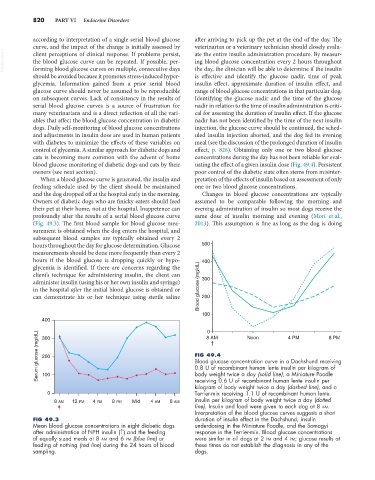Page 848 - Small Animal Internal Medicine, 6th Edition
P. 848
820 PART VI Endocrine Disorders
according to interpretation of a single serial blood glucose after arriving to pick up the pet at the end of the day. The
curve, and the impact of the change is initially assessed by veterinarian or a veterinary technician should closely evalu-
VetBooks.ir client perceptions of clinical response. If problems persist, ate the entire insulin administration procedure. By measur-
ing blood glucose concentration every 2 hours throughout
the blood glucose curve can be repeated. If possible, per-
forming blood glucose curves on multiple, consecutive days
is effective and identify the glucose nadir, time of peak
should be avoided because it promotes stress-induced hyper- the day, the clinician will be able to determine if the insulin
glycemia. Information gained from a prior serial blood insulin effect, approximate duration of insulin effect, and
glucose curve should never be assumed to be reproducible range of blood glucose concentrations in that particular dog.
on subsequent curves. Lack of consistency in the results of Identifying the glucose nadir and the time of the glucose
serial blood glucose curves is a source of frustration for nadir in relation to the time of insulin administration is criti-
many veterinarians and is a direct reflection of all the vari- cal for assessing the duration of insulin effect. If the glucose
ables that affect the blood glucose concentration in diabetic nadir has not been identified by the time of the next insulin
dogs. Daily self-monitoring of blood glucose concentrations injection, the glucose curve should be continued, the sched-
and adjustments in insulin dose are used in human patients uled insulin injection aborted, and the dog fed its evening
with diabetes to minimize the effects of these variables on meal (see the discussion of the prolonged duration of insulin
control of glycemia. A similar approach for diabetic dogs and effect, p. 826). Obtaining only one or two blood glucose
cats is becoming more common with the advent of home concentrations during the day has not been reliable for eval-
blood glucose monitoring of diabetic dogs and cats by their uating the effect of a given insulin dose (Fig. 49.4). Persistent
owners (see next section). poor control of the diabetic state often stems from misinter-
When a blood glucose curve is generated, the insulin and pretation of the effects of insulin based on assessment of only
feeding schedule used by the client should be maintained one or two blood glucose concentrations.
and the dog dropped off at the hospital early in the morning. Changes in blood glucose concentrations are typically
Owners of diabetic dogs who are finicky eaters should feed assumed to be comparable following the morning and
their pet at their home, not at the hospital. Inappetence can evening administration of insulin so most dogs receive the
profoundly alter the results of a serial blood glucose curve same dose of insulin morning and evening (Mori et al.,
(Fig. 49.3). The first blood sample for blood glucose mea- 2013). This assumption is fine as long as the dog is doing
surement is obtained when the dog enters the hospital, and
subsequent blood samples are typically obtained every 2
hours throughout the day for glucose determination. Glucose 500
measurements should be done more frequently than every 2
hours if the blood glucose is dropping quickly or hypo- 400
glycemia is identified. If there are concerns regarding the
client’s technique for administering insulin, the client can
administer insulin (using his or her own insulin and syringe) 300
in the hospital after the initial blood glucose is obtained or Blood glucose (mg/dL)
can demonstrate his or her technique using sterile saline 200
100
400 8 AM Noon 4 PM 8 PM
0
Serum glucose (mg/dL) 300 FIG 49.4
200
Blood glucose concentration curve in a Dachshund receiving
0.8 U of recombinant human lente insulin per kilogram of
body weight twice a day (solid line), a Miniature Poodle
100
receiving 0.6 U of recombinant human lente insulin per
kilogram of body weight twice a day (dashed line), and a
0 Terrier-mix receiving 1.1 U of recombinant human lente
8 AM 12 PM 4 PM 8 PM Mid 4 AM 8 AM insulin per kilogram of body weight twice a day (dotted
line). Insulin and food were given to each dog at 8 AM.
Interpretation of the blood glucose curves suggests a short
FIG 49.3 duration of insulin effect in the Dachshund, insulin
Mean blood glucose concentrations in eight diabetic dogs underdosing in the Miniature Poodle, and the Somogyi
after administration of NPH insulin (↑) and the feeding response in the Terrier-mix. Blood glucose concentrations
of equally sized meals at 8 AM and 6 PM (blue line) or were similar in all dogs at 2 PM and 4 PM; glucose results at
feeding of nothing (red line) during the 24 hours of blood these times do not establish the diagnosis in any of the
sampling. dogs.

